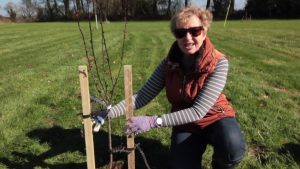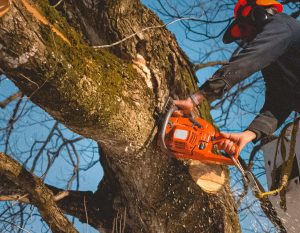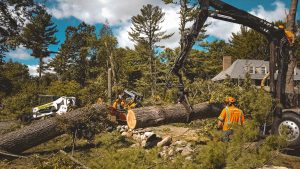Mistletoe, which is frequently connected with seasonal customs, is not always a welcoming sight when it takes root in our trees. This parasitic plant can harm the health and longevity of its host tree. To maintain your trees’ health and strength, you must master the skill of properly removing mistletoe. This article will walk you through the step-by-step procedure of securely and quickly How To Remove Mistletoe From Trees, allowing these natural wonders to live without this invasive guest
Manual removal
Pruning Shears or Loppers:
When beginning the mechanical removal of mistletoe, it is critical to first locate the afflicted branches on the tree. Mistletoe often appears as clusters of green, leafy growth on the branches.
Equip yourself with a good pair of pruning shears or loppers. These tools will help you make precise cuts while minimizing harm to the host tree.
Sanitizing Equipment:
It’s critical to clean your pruning equipment between cuts. This procedure is crucial to preventing the spread of mistletoe seeds or diseases to other areas of the tree. To sanitize your instruments, add one part bleach to nine parts water and wipe down the blades after each use.
Mistletoe disposal
Collect the mistletoe plant material carefully when you cut away the mistletoe clusters. Make sure it doesn’t fall on other branches or areas of the tree, as mistletoe seeds can reattach and flourish.
Remove the mistletoe from the local vicinity. This eliminates the possibility of reinfestation and minimizes the chance of mistletoe seeds spreading to neighboring trees.
Regular Inspection:
Mistletoe removal is a continuous procedure, not a one-time task. Mistletoe can reappear over time, especially if it’s nearby. Inspect your tree on a regular basis for fresh mistletoe growth and repeat the mechanical removal method as necessary.
Chemical control
Application of Herbicides:
If the mistletoe infestation is strong or chronic, try employing a systemic herbicide. Systemic herbicides are absorbed and distributed throughout the plant, ensuring effective mistletoe control.
However, before using herbicides, it is important to have a conversation with a certified arborist or horticulturist. Based on the type of mistletoe and the tree species involved, they can prescribe the best herbicide.
Timing is everything.
Herbicide application time is crucial for success. Herbicides should be applied in late winter or early spring, when the host tree is dormant. During this time, mistletoe is more vulnerable to herbicide uptake.
Apply with Caution:
Use precision when applying herbicides. Follow the manufacturer’s dose and application directions to thoroughly coat the mistletoe’s foliage or stems. Herbicides can be harmful to the host tree’s leaves; therefore, avoid overspray.
Follow-up and monitoring:
After applying the herbicide, keep an eye out for evidence of decline in the treated mistletoe. The mistletoe may take several weeks to wither and perish.
When the mistletoe branches are clearly no longer alive, carefully remove them from the tree to prevent dead, decaying material from affecting the health of the host tree.
Considerations for the Environment
Herbicides must be used responsibly in order to protect the environment. Consider the potential effects on the surrounding ecosystem and wildlife. To avoid environmental damage, follow all local pesticide restrictions and standards.
Why removing mistletoe is important
Mistletoe removal from trees is necessary for numerous reasons:
1. Tree health
Mistletoe is a parasitic plant that attaches itself to the branches and stems of trees. It draws water and nutrients from the host tree, weakening it over time. Mistletoe’s proliferation can impair the tree’s capacity to grow, reproduce, and endure environmental challenges.
2. Structural Integrity:
Mistletoe infestations can damage the structural integrity of the host tree. Mistletoe clumps add weight to limbs, increasing the danger of limb failure or even tree collapse during storms or inclement weather.
3. Disease Prevention:
Mistletoe provides access routes for infections, fungus, and pests. The weaker places where mistletoe attaches become vulnerable to infections that might further injure the tree. Removing mistletoe lowers the danger of disease and increases the tree’s lifespan.
4. Aesthetic Appeal:
Mistletoe can alter the host tree’s branches and leaves, ruining its natural shape and beauty. Removing mistletoe restores the tree’s beauty, allowing it to grow in its intended form and improving the entire scene.
5. Preventing Spread:
Birds disperse the seeds of mistletoe. By removing mistletoe as soon as possible, you can prevent the spread of this parasitic plant to other trees nearby.
Tree removal
In the field of arboriculture and landscaping, tree removal should always be considered a last resort. Trees are living creatures that provide various ecological, aesthetic, and utilitarian benefits. Before choosing to remove a tree, an in-depth inspection should be done to investigate options such as pruning, disease management, or structural support. Trees contribute to better air quality, shade, and wildlife habitat, making their preservation critical. Mature trees are also historically and culturally significant in many places. As a result, removing a tree should be approached with caution and a genuine respect for the benefits it provides to both the environment and our lives.
Impact of mistletoe in trees
Mistletoe is generally connected with seasonal customs, and it can have a major and negative impact on trees. This parasitic plant attaches itself to the branches and stems of its host tree, sucking crucial nutrients and water and gradually weakening the tree. Mistletoe’s proliferation impairs the tree’s natural growth and development, limiting its ability to reproduce and endure environmental challenges. The extra weight of mistletoe clumps might weaken the tree’s structural integrity, increasing the danger of limb failure during storms. Furthermore, mistletoe creates access routes for diseases and pests, which can further injure the tree. To ensure the health and lifespan of trees, it is critical to recognize and manage the detrimental impact of mistletoe through appropriate removal and control procedures.
Related Posts:
How to remove palm tree roots?
1. What is mistletoe, and why is it harmful to trees?
Mistletoe is a parasitic plant that attaches to trees and extracts nutrients, potentially weakening and damaging the host tree over time.
2. Can mistletoe be harmful to humans or pets?
Mistletoe is generally not harmful to humans or pets unless ingested in large quantities. However, it’s best to avoid contact due to its potential toxicity.
3. When is the best time to remove mistletoe from trees?
The ideal time for removal is in late winter or early spring, when the host tree is dormant and mistletoe is most vulnerable.
4. Can I simply cut the mistletoe out of the tree?
Cutting alone may not suffice. It’s essential to remove mistletoe entirely, including its roots, to prevent regrowth.
5. Are there any safety precautions to take when removing mistletoe?
Yes, wear protective gear like gloves and safety glasses. Be cautious of falling debris and consider hiring professionals for tall trees or extensive infestations.
Conclusion
To preserve the health and vitality of our beloved tree, the removal of mistletoe is an essential practice. Mistletoe, although steeped in holiday tradition, can pose a serious threat to the trees it inhabits. By following the recommended removal method, we can protect the well-being of our trees while ensuring their beauty and strength



